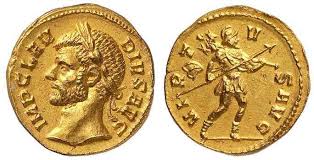On 31 December 192, members of the Praetorian Guard
assassinated the Emperor Commodus. He was the first ruler to be killed in 96
years, Before the end of 193, two more emperors had died and Rome had split
into three states fighting a vicious three way civil war. Money, ambition,
politics and religion broke the Roman Empire again and again over the following
centuries. Rome itself no longer counted. The temples of the classical gods
were ransacked, Roman armies were mainly filled with foreigners till there was
little difference between the two. People who held Roman citizenship sacked
Rome.
The first crack:
In the second half of the second century, the Roman Empire
suddenly lost half of its population to plague, probably smallpox (165-180AD).
Even the emperor’s brother died of it. The plague had arrived from Persia with
a returning army, coming back to fight the rising Germanic problem to the
north.
Commodus (reigned 180–192) was faced with a slump in tax
money just when he needed more. He doubled taxes. Naturally people objected, so
he made his rule fiercer to prevent an uprising. The more he oppressed people,
the more they wanted him gone.
If ever there was an example of ‘be careful of what you wish
for’, the murder of Commodus was it; a spate of short-term emperors were
murdered and Rome fell into three states, west, middle and east, and it took
years to put back together.
Didius Julianus, the billionaire who bought the Empire, AD193 (for two months!)
The second crack:
Over fifty years from 235 to 284AD, twenty emperors ruled,
which makes the average reign two and a half years. In addition, about thirty
others tried to become emperor, and the only difference between legitimate
emperors and usurpers was that the former won and the latter lost.
Each emperor withdrew the silver coinage of the previous
one, replacing it with his own, each in turn reducing the silver content, so
eventually what had once been almost pure silver became a coin of base metal
with a thin silver wash. Shopkeepers could see this, so they put their prices
up, leading to massive inflation.
Of those twenty emperors, seventeen were assassinated within
five years, some within weeks. One died of plague, one vanished into the marshes
in enemy territory never to be seen again, and one was captured by the Persians
and used as the shah’s footstool for years. To try and hold Rome together, the
emperors decided to persecute Christians for the first time in a century, but
the more they martyred, the more were inspired to join so they could be
martyred too.
In the middle of this second crisis period, plague returned
(c.250–70), either smallpox again or possibly rinderpest, a relative of
measles. The Empire was again devastated, as were external enemies who attacked
it.
It wasn’t a happy time.
The third crack:
In 260AD, the leaders of the western section, the Prefecture
of the Gauls, declared independence, and maintained it for fourteen years. At
its height, the Gallic Empire included Britain, Gaul (France, the Low
Countries, parts of Germany and Switzerland), Hispania (Spain and Portugal) and
Tingis (Tangiers). We do know, however, that they saw themselves as the ‘real’
Roman Empire, as one emperors was Domitian II, and Domitian I was a ‘real’
emperor of the first century AD. The breakaway state survived to AD274 under
Tetricus as emperor. The state had consuls and a senate of its own.
Zenobia
At the other end of the empire in AD267, the Roman governor
of Palmyra and local king was murdered, which provoked his wife Zenobia (a
Romanised version of Zainab) who proclaimed independence of Palmyra, rapidly
expanding a Palmyrene empire across Syria, the Levant, Egypt and eastern
Anatolia. She was defeated in AD274, taken to Rome, but pardoned and married a
senator. She claimed descent from Dido, mythical queen of Carthage, and
Cleopatra VII (the famous one) of Egypt, which suggests she was well aware of
Roman culture.
The ruler who defeated both Zenobia and Tetricus was
Aurelian (reigned 270-275). He did a lot to reunify and stabilise the empire.
He spared both Tetricus and Zenobia, showing wisdom, and built the wall around
Rome that survives to this day. He successfully defended the core empire from
numerous Germanic attacks and sensibly abandoned the undefendable province of
Dacia (modern Romania). He was strict in fighting corruption and improved the
quality of coinage. He executed corrupt mint officials who were stealing the
empire’s silver. His anti-corruption measures caused him to be assassinated on
his way to fight the Persians.
The oddness of these third century times can be seen in the
rising authority of women. Beside Zenobia, we see the Victoria, mother of one
Gallic emperor, who ruled in her own name after his death (even issuing her own
coins), and Ulpia Severina, who ruled on her own as ‘mother of the camps, the
senate and fatherland’, after the murder of her husband Aurelian. The pragmatic
use of women in leadership roles in the third century follows on from their
cultural impact, seen in the case of Julia Domna, the wife of Septimius
Severus; she commissioned literary works and provided a literary salon for
authors. She was a Syrian, like Zenobia.
Probus (reigned 276–283) in six years repaired a lot of the
damage, building on the good work of Aurelian. His major contribution was in
defeating Germanic incursions and setting some Germans in Britain as guards.
The improved stability he created is one reason why Rome survived.





No comments:
Post a Comment